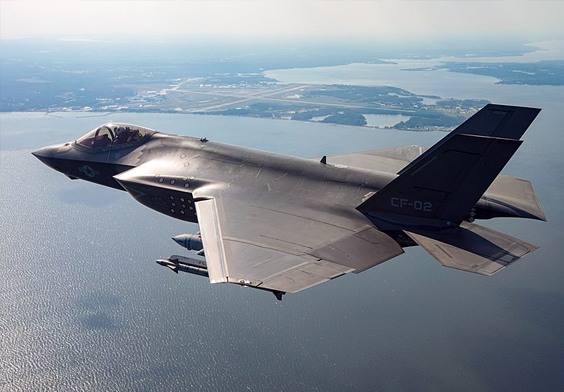September 8, 2020
Jessica Varnum and Can Kasapoglu
The following was originally published in The National Interest.
As the United States embargoes Turkey from further participation in the F-35 Joint Strike Fighter Program, and Congress seeks to impose so-called “secondary sanctions” on Ankara for its acquisition of a Russian strategic surface to air missile (SAM) system, the alliance seems to be standing on a precipice. Even those of us who have spent the better part of our careers advocating for strong bilateral relations question how to walk the alliance back from the brink. According to New York Times editorialist C.L. Sulzberger, “The arms embargo is regarded, to use the words of Foreign Minister Caglayangil, as ‘a hostile move’ by one ally against another. …Turks bluntly regard the boycott as United States blackmail designed to weaken them.”

F-35 in flight, Source: WikiMedia Commons
And yet, the United States and Turkey have considerable experience walking back from the brink when all hope seems lost. That editorial quote, which perfectly echoes many of today’s challenges, was published in 1975 at the height of a different arms embargo on Turkey, imposed by Congress over Turkey’s military intervention in Cyprus. Then, as now, Western policymakers worried that Turkey would break decisively with NATO to pursue alternative partnerships. But while the Cold War has been over for more than three decades, and provocative military deals like the S-400 suggest a cozy Turkey-Russia alliance, Ankara still finds itself squaring off against Moscow regionally in a string of ongoing conflicts from Syria, to Libya, to the present outbreak of violence between Azerbaijan and Armenia. There may still be time to walk U.S.-Turkish relations back from the brink, and as participants in an ongoing U.S.-Turkey-NATO dialogue project, facilitated by Carnegie Europe and Turkey’s Center for Economics and Foreign Policy Studies (EDAM), we believe resolve on both sides must be summoned to do so.
The Real Cost of the S-400
To understand the near intractability of the S-400 problem for NATO alliance relations, a technical aside is necessary. From a military standpoint, Ankara’s S-400 procurement comes with significant technical problems for operating NATO-friendly military assets such as the F-35 Joint Strike Fighter within Turkish airspace. Turkey does not, and will not in the foreseeable future, have any technical involvement in the primary maintenance of the Russian system, as there has been no technology transfer concerning the S-400’s algorithms or design. This bitter reality can be succinctly expressed; in the absence of a comprehensive technology transfer or co-production package, Turkish defense planners will never fully know what the Russian strategic SAM system is doing in Turkey, including whether it has any cyber or electronic backdoors clandestinely transferring data on NATO military assets to Moscow. In specific terms, this means one cannot rule out the risk of the S-400 studying and reporting back to Moscow regarding the F-35’s stealth features, which would endanger the U.S.-allied global fleet from Western Europe to Eastern Asia. Feeding into this worry, in November 2019, Turkey tested the S-400’s sensors (probably its identification friend-or-foe (IFF) system or radar blind-sectors) on the US-manufactured F-16 and F-4 fighters which form the backbone of the Turkish Air Force’s doctrinal order of battle. This was a bold move, souring the mood within the American strategic community. While Ankara has many times called for the establishment of a joint commission to ensure the security of F-35 data, it is ironically only Putin’s Russia that could offer such guarantees.
Continue reading at The National Interest.
